
The Early Childhood Development (ECD) team in Telangana has started supportive supervision training to help supervisors use the Nutrition and Health Tracking System(NHTS) Supervisor app effectively. The aim is to improve growth monitoring accuracy and strengthen field supervision. Kamareddy is one of the three districts where we are piloting this intervention in collaboration with UNICEF. The training was planned over two days—one day of classroom training at the district collectorate office and a second day of field visits to shadow supervisors and observe how they use the app in real settings.
The training session on the first day was held in a well-furnished, air-conditioned conference room. The session went smoothly, and the supervisors seemed engaged and receptive to the app. On the second day, we split into three teams to visit different sectors. I accompanied a supervisor and a block coordinator to their sector. Ideally, each supervisor is assigned to one sector, but this supervisor was responsible for three, which means that her workload was more than it should be.
The first Anganwadi Centre (AWC) we visited was located behind a government primary school. As we entered, the supervisor quietly mentioned that these were some of the most neglected AWCs. The condition of the center reflected her words—there were no toilets, the roof leaked, and the walls were in poor shape. Inside, four preschool children were playing quietly among themselves, while the Anganwadi worker and helper were present. The supervisor requested the Anganwadi Worker (AWW) to bring a few children under three years old for measurement, as she needed at least five children to complete the visit log in the app. The AWW hesitated, unsure whom to call, so the supervisor sent the Anganwadi Helper (AWH) instead.
Measuring children turned out to be far from easy. They cried, shouted, and were visibly scared as they were placed on the Salter scale. For younger children, it was even more challenging. They constantly moved, making it difficult to take accurate measurements. Eventually, four infants arrived with their mothers. According to the AWW’s records, there were no malnourished children in the centre. But after the supervisor took fresh measurements, at least four children were found to be moderately malnourished.
What stood out the most was the reaction of the mothers. They had never really paid attention to growth monitoring before. For them, it had always been something the government required—another task on a long list of formalities. But as the supervisor explained the meaning of the growth charts and what they indicated about their child’s nutrition, the mothers started asking questions. What should they feed their children? How could they ensure proper growth?
We then moved to the second Anganwadi centre, we had to cross an open sewage line to get inside. The building was in terrible shape. The walls looked dangerously weak, and with just one heavy rain, they could collapse. A few mothers were at the centre, voicing their frustrations about the condition of the AWC and the irregular ration supply. They seemed desperate for a change, but their complaints had gone unheard for a long time.
These were only a few centres we visited, and they do not reflect the full picture, but they showed us that these AWCs require attention. These visits were reality checks for us and are lived experiences that will stay with me. They made me realise how much more needs to be done beyond just training and supervision. The issues on the ground—whether it’s overloaded supervisors, undertrained AWWs, poor infrastructure, or low awareness among beneficiaries—cannot be ignored. This experience will help me think more holistically in the future, beyond just data and policies, and focus on the people and their everyday realities.
